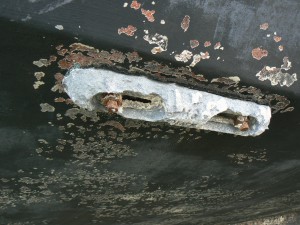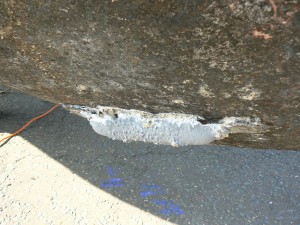ALL ABOUT ANODES FOR LEISURE BOATS
” Plus Bonding Systems “
How do sacrificial anodes help keep your boat in good condition and possibly afloat
Pictures – Hull anodes that ” No longer have sufficient mass to be effective “
In a few words, how galvanic corrosion works.
Any two dissimilar metals submerged together in an electrolyte – sea water in our case – will create an electrical current known as a galvanic cell (like a battery), with the less noble (more active) metal, a bronze propeller for instance, forming the anode and the more noble (less active) metal, a stainless steel shaft, forming the cathode. The electrical current will travel from the less noble metal, anode, to the most noble metal, cathode, depleting the anode from its core material in the process.
The bronze propeller will gradually corrode away and this is where trouble will start.
The way around it is by adding a sacrificial anode to the system.
This anode will need to be made of a more active metal than the other two and thus the bronze propeller will now become a cathode and be protected.
That’s all fine when looking at a simple assembly such as a prop and prop shaft. Stick an anode on the shaft and that is generally sufficient but how about a bronze seacock and through-hull fitting? Not very practical to stick an anode on each one of them. So the answer is to electrically bond them to the anode.
All immersed metal components should be connected to the cathodic protection. Many ingenious systems exist to bond the engine, prop shaft and propeller and you should see with your engineer what would be best suited for your boat.
Anodes on non ferrous boat are generally bolted through the hull. Easier than welding onto a GRP hull or a wooden one!
But that’s great because now we’ve got two studs inside the boat connected to the outside anode. So now we can wire (bond) the seacocks to the anode’s studs, and the engine and prop shaft to another, or the same one depending on the size of the boat, and the amount of dissimilar metal within close range of each other. One thing to remember is that anodes can “see” the parts to be protected so long as the circuit is not broken.
A few things to look at when connecting them is that the connection is well made and kept on the inside of the hull and clear of bilge water.
Also, when you pop your head down the bilge, have a quick look at the connection as the bond might be broken due to galvanic corrosion and now what you were thought was protected by the anodic circuit is now isolated and will corrode.
Different Waters = Different Anodes
Three different types of anodes can be used:
- Fresh water Magnesium
- Salt water Zinc
- Brackish water Aluminium
The surface of a zinc anode when left in fresh water for some time become covered with an off-white crust. This will effectively seal the anode and stop it working when it is returned to the salt water. The consequences are that the next most anodic item bonded to the anode will start to sacrifice itself. It is therefore important to check the anodes after trips into fresh water. Also, if keeping the boat on the Norfolk Broads or brackish waters, aluminium anode would be a preferred choice to protect the vessel.
It is important to have them replaced when they reach ~50% of their original mass as the rate of galvanic corrosion is accelerating and your protection diminishing.
For Information: Very rapid zinc anode loss that results in bright, shiny metal being exposed is a clear indication of electrical activity, be it galvanic or stray current, usually the later, since galvanism rarely creates enough current to destroy zincs quickly .
Bright zinc in association with heavily corroded bottom paint means you have a problem that needs to be addressed immediately. The brightness of the zinc is telling you that there is too much current for the zincs to handle. Adding more zinc is NOT the solution
Earthing – Bonding Systems:
The purpose of a bonding system is to equalize the electric potential of dissimilar underwater metals by tying them all together with wire or copper straps. The benefits of a bonding system are wide ranging but little perceived. One is that it serves to dissipate stray current leaks. 12 volts of current focused on a small piece of metal will result in rapid destruction.
But that same 12 volts spread over a much larger surfaces, causes less damage in proportion to the size of the water exposed surfaces of the metal. Bonding systems can reduce the corrosion potential of metals inside and on the bottom of the boat.
Vessels which have all the hardware bonded, such as the railings, will suffer much less corrosion. The general rule is that anytime a piece of metal plumbing or hardware is isolated in a system, as with a sea strainer that is joined by two hoses is electrically isolated, needs to be wired into the system.
This can be done by daisy chaining items together, but it’s a good idea not to include too many items in a chain. Obviously, at any point where a connection is broken, all those items upstream will be unprotected.
DC Current leaks are the most common form of a stray current problem
Yes I know, We’ve just added another box to your winter maintenance tick list But hey, they need to be looked after.
Stern Drives, Outboards & Sail Drives
Now for those of you with a sterndrive, outboard or saildrive, things are bit more sensitive. See an earlier post SeaRay 290 Sinking – Mercruiser Stern Drive Investigation
As they are made in aluminium for lightness reasons, although of a high quality they are very prone to galvanic corrosion. It is very important to keep all the anodes in good condition i.e the anodes are depleting and not the stern drive casing. I often found that the little braided wire connecting the casing to the anodes was broken so make sure to keep the connection live!
Although the standard propeller is generally made of aluminium on those units it might have been replaced by a stainless steel prop for better performance, thus changing the situation. You will need to review your cathodic protection and install an extra and bigger anode.
Another silly one is when the ‘sport’ boat is moored, the sterndrive is often kept out of the water, which in some ways is a good practice. But on some boats the leg cannot be fully titled out of the water, leaving the gearbox partially immersed while the anodes are nicely dry in the sunshine enjoying their holiday and not doing much to protect the gearbox. It will lead to a rapid deterioration of the gearbox casing and resulting in water ingress.
To overcome that issue you can either fit an extra anode on the transom or hang some over the side of the boat (in the water) close to the leg.
Someone once told me that you can only have over protected your boat when it sinks from the weight of the anodes!
But most of all remember that a painted anode doesn’t work at all You can see the evidence by the end of the season when the anode is still painted and your prop is almost gone!
Now here is a simplified galvanic series. Platinum is pretty much up there on top of the noble metals but I thought I would stick to materials actually used in boat building just to keep it relevant to us.
Steel Hulls / Cathodic Protection
Currently most UK canal boats do not have enough anodes fitted to provide protection to all of the hull. Often we see vessels of considerable length (60ft plus) with only 4 hull anodes fitted. Typically 2 at the bow and 2 at the stern. Our literature has perhaps not helped as we do show vessels up to a wetted surface area of 56m2 with 4 anodes for protection and vessels up to 70m2 with 6 anodes. I would suggest that all vessels should as a minimum have 6 anodes, and as the vessels get longer in length they should have 8. I will be looking at updating our own literature to reflect this.
From a technical point of view an anode will only “throw” its protective current roughly 7 times its own length, which is why anodes are required to be equally spaced along the hull of the vessel to ensure good coverage. From this you can see that just fitting 4 anodes to a typical canal boat is not adequate protection for the entire hull. I suspect that most pitting corrosion you see is at the mid ships position, as this is the furthest point from the bow and stern mounted anodes.
The flip side to the argument for better cathodic protection is possibly that most canal boats operate in fresh water and this is a far less aggressive medium to salt water. Plus that anodes are used to provide a back up to a good protective paint system. However I still feel a belt and braces option is always best and especially verses the cost of hull plating.
Galvanic Series:
In this sample list, the metals and alloys are arranged in order of their potentials, measured with reference to an electrode immersed in salt water.
The list is arranged 00 – 12 with the least noble metals # 12 (ANODIC) at the top end and the most noble # 00 (CATHODIC) at the bottom.
ANODIC MOST ACTIVE
12: MAGNESIUM ALLOYS
11: ZINC
10: GALVANISED MILD STEEL
09: ALUMINIUM ALLOYS
08: MILD STEEL
07: LEAD
06: GUNMETAL
05: MANGANESE BRONZE
04: NAVAL BRASS
03: SILICON BRONZE
02: COPPER
01: MONEL
00: STAINLESS STEEL
CATHODIC – NOBLE PASSIVE / LEAST ACTIVE
For more information contact European Marine Services Ltd. Marine Surveyors & Consultants
EMS also undertake Boat Safety Inspections & Engine Inspections
www.europeanmarinesurveys.com
Tel: 01603 327 123








